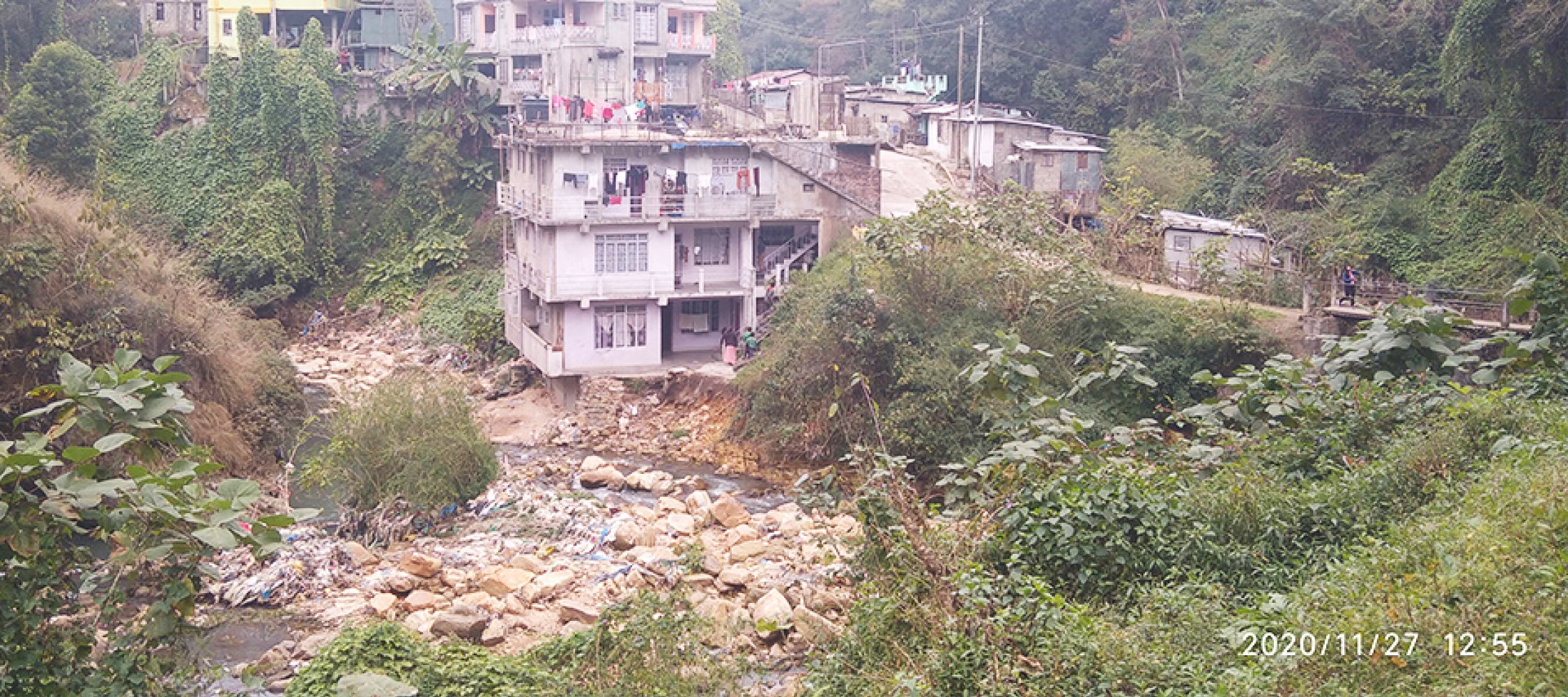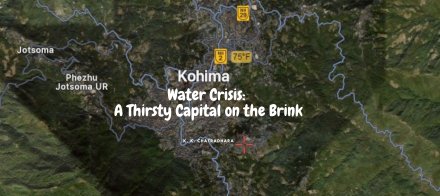 |
The wooden wheels are down the rough, dusty roads. Voices of young kids running and screaming in excitement behind the wooden rollers accompanied by the clinging of empty mustard oil tins are heard all along the way till they reach the Ka Per Moina, a source of spring water where people come to fetch water. It is early in the morning, but there are already people queuing up for their turn to fill their buckets. I am one of the kids hanging on the Kali head (water carrier made of wooden wheels and planks) along with my sisters going to fetch water, which is our daily routine. Well, that was around 31 years ago, and I was around 10-year-old then.
My memories revolve around this spring water. Reminiscent of the place, my mother Susanna Kharkongor, 67, pleasantly recalls her experience when she was around 10-year-old: “Playing around near Ka Per Moina with our friends, while waiting for our turn to collect water was my most compelling memory till now.” She also clearly remembered how young men would light up fire beside the road at the lai lad (tri-junction) of Centre Nongrim Hills in the evening to brighten up the area. At the same time, they would wait for their turn to fill water from the Um-Syiem pipe, a public water tap, provided by the administration of the Hima Mylliem, the native Khasi state.
I can even remember the water tap that my mother is talking about. The only difference is that I have never seen the water coming out from the tap, but the memory of an old cobbler named Gulab is imprinted in my mind about the tap. As a young boy, I didn’t recall seeing anyone carrying a cone basket to fetch water, as my mother narrated.
“With a cone basket and a khiw-phiang (10-20 litres) on my back, I cannot forget how I trudged all the way from home going uphill to Demthring – another source of spring water, situated at a distance of 2/ 3 km from Nongrim Hills – and back home just to get our drinking water,” our 66-year old neighbour, Kong AmabellShadap, said.
Referring to the Um-Syiem tap, Kong Kathleen Marbaniang (67), another neighbour, said when she was 2-year-old, her parents shifted from Laitumkhrah and settled down at the upper Nongrim Hills. She remembered fetching water from the Um-Syiem tap located there. According to her, the Um-Syiem taps were set up in all the three parts of the locality – Upper, Centre, and Lower Nongrim Hills. Interestingly, the water tap which Kong Kathleen referred to in the Upper Nongrim Hills is still functional.
Listening to the water stories of the past, I must say, fetching water was more fun and adventurous than tiresome. None of them complained about going to far-flung areas to fill just a few litres of water. “When it’s time to go and fill water, I will get very excited,” recalled Kong Altricia Shadap, a 70-year-old elder in the locality. “My mother would pack tamarind for me along with salt and chili powder, and I would have it along the way with my friends. We would go and collect water two-three times a day and even fill in the little bowls in the house,” she said.
Apart from the spring water and Um-Syiem tap water, a few streamlets are around the Nongrim Hills. “We used to go and wash our clothes in Wah Thangsniang, a small stream, now reduced to a filthy drain clogged with household wastes that flow down between the Bethany Hospital and the Brookeside school, and the then Seventh Day Adventist Church. There was also a natural spring near the church where people would collect water or take a bath,” Kong Kathleen said. I remember the spring water that used to flow out from the school wall, but now it is no more there.
Wah Umpling, Wah-Umkhrah, Wah Myrsiang, and Wah Thangsniang were the destinations for washing clothes for most of the locality residents. I feel lucky enough to have memories around at least two streams, Wah Myrsiang and Wah Umpling, located just a few metres away from my residence. I clearly remember how I crawled under the Wah Umpling stream and was about to get drowned since I could not swim. Recently, I was shocked to see a house being built just beside it, where there used to be a pool-like stretch in the stream, where boys used to go swimming, especially during their holidays. But, sadly, these streams also have been reduced to drains now.
Ironically, even though there were natural springs and many streams all around us, drinking water was still a problem.
In the past few decades, the water situation worsened partly due to the growing population and urban growth with booming construction of houses, commercial buildings, roads, and other civic infrastructure. All these have caused loss of forest and degradation of natural springs and streams.
After Meghalaya came into being as a full-fledged state, the first piped water supply was introduced in Shillong in the late 1970s by the Public Health Engineering (PHE) Department. The residents were indeed very excited when they got their first water connection. But the most memorable part about this water, my mother recalls, was that “it was muddy red”. Even though it was better to have water than not to, the water supply was not sufficient.
According to Kong Lucy Marbaniang, around 1984, the PHE water supply was for around 10 minutes to fill only two-three buckets, which was insufficient. “We had to go and get water every day and then go to the office,” she said. “Even now, relying just on the PHE water supply is difficult. During the monsoon months, many households in the locality would collect rainwater for washing and cleaning, and use the piped water supply for cooking. But, when winter months arrive, purchasing water is the only option.”
My mother says the present life is much easier than the olden days; easier because we don’t go looking for water everywhere anymore. Getting water is just a phone call away but at a price, of course. The price varies from one supplier to another, depending on their water tank capacity. Besides, many households are now tapping groundwater by using electric pumps.
Buying water has been a part and parcel of our lives for generations now. Presently, I pay Rs.350 for 1,800 litres of water. Kynsai Janong, who drives an 1,800-litre tanker, says he makes about 13-14 trips on a normal day. At times, when there is less demand, it’s below five trips. In the dry winter months, the demand is more; he makes around 20 trips in a day. “With insufficient supply of water and an increasing population, this business is booming all around the town, and I have never missed the sight of at least one water tanker a day. But even 50 to 60 years ago, people were buying water. One bhar (two-tins, 14 –15 litres each) would cost about Re.1 or Rs.2,” Kong Kathleen said.
However, to solve this prolonged pending water scarcity in the locality, the Dorbar Shnong (local dorbar/council) set up bore wells in different parts of the locality in 1997. I still remember how excited I was to fetch water from our new pumps near the butcher shop in Centre Nongrim Hills. I had seen people pumping water only on television then. Most of the businesses required more water. For bigger establishments, like the Landmark Victoria Hotel situated in Upper Nongrim Hills, groundwater seems to be their only solution to their high water consumption demand.
In May 2019, the sound of drilling was heard echoing in the locality all over again, and in the same location. However, this time, the new Dorbar remained silent. There was no hue and cry, unlike in 2015.
I wondered what went wrong with the Dorbar this time that they had to submit to the hotel administration’s wishes. So, I gathered a few residents from the locality and went up to meet the headman. We requested him to ask the hotel administration to stop their drilling work until a decision is taken by people (Dorbar Paidbah). He explained that this was a community service and water would be distributed to the residents.
I disagreed with his explanation. But, I felt that the Dorbar would find out ways to solve our water needs if the situation arose. Anyway, we have lived so many generations by buying water. As long as we have surface water, we can purchase it to resolve the water issue. Tapping the underground water, I feel, will be our last resort. Later, I found out that it was the local authority, which offered the hotel owner to drill the underground water in the name of community service.
Moreover, knowing that this drilled water would not be shared among the community as proposed, I started a signature campaign among the residents. But, the fear to stand against the authority restricted the residents and youths to tag along with me. This did not deter me. By the time I submitted my letter, the pumping of water had already begun. But, the Dorbar still failed to address the issue. We had an inspection and found out that the hotel was using the underground water for commercial purposes. The headman had earlier informed that an arrangement was made between the Dorbar and hotel administration and that a half of the pumped groundwater would be provided to the nearby residents, thus solving the water problems of a few families. But it was not followed by the hotel administration.
My fight was finally taken over to the Dorbar meeting after several months. I knew I was facing a giant opponent as none of the MDC’s or MLAs could interfere and would be of any help even if I approached them. I already approached them in writing, but they were of no help. Finally, after much debate with the authority at the meeting, they decided to consider the people’s vote.
However, I was surprised at the Dorbar instructions. They made it mandatory for all the voters to pen down their names and addresses in a paper. I stood up to protest against this undemocratic way of voting, but my voice was subdued. I understood where this whole voting system was taking us, and I could sense that most people were intimidated by this move. I knew it wasn’t easy to go against the authority, which was evident from the results. There were more ‘Yeses’ to drilling than ‘Nos.’ However, I am grateful to the few who stood by and believed in me. For some, I have lost the fight, but I feel I have emerged stronger than before. I finally sighed a sense of relief and felt accomplished what I intended. I thought that my fight was finally over. I was against the drilling of water for commercial purposes, but I was fighting to secure the verdict of the people who had opposed drilling in 2015 and see whether they had changed their views at this critical issue
I hope Ka Per Moina survives the onslaught of the so-called development, and I hope my children will be able to see the natural spring as my mother and I did and appreciate its value, and not just read about it. And I pledge to continue my fight for the benefits of the community as a whole.
Geolocation is 25.569161361657542, 91.90515243378087


